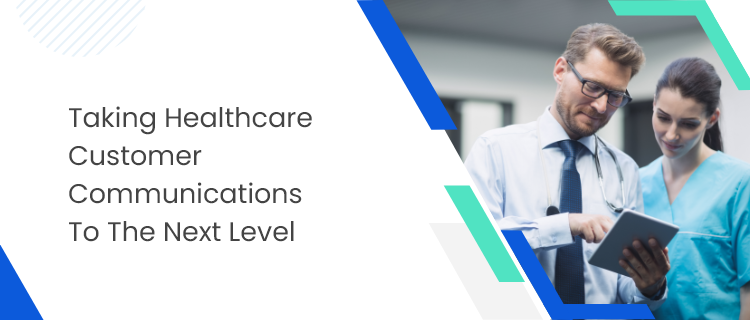In the ever-evolving healthcare industry, the patient experience has taken center stage. Patients are no longer passive recipients of care; they are informed consumers who expect transparency and timely communication from their healthcare providers. Understanding the profound impact of transparent and timely customer communications is vital for organizations aiming to deliver an exceptional healthcare patient experience and achieve sustainable success in the competitive industry.
Enhanced healthcare patient communication and engagement are the ‘mantra’ of success. It’s especially true in healthcare, where effective communication strategies are not just about yielding a market share but also have the potential to save lives. Data reveals that in the U.S., almost half of the patients switched service providers due to poor experiences, and nearly 85% of these individuals made this decision because companies didn’t offer ease of doing business with them.
Customer communication inefficiencies directly impact productivity, efficiency, and last but certainly not least – cost!
- A 500-bed hospital loses $4+ million every year due to communication inefficiencies
- Miscommunication during patient transfers is responsible for 80% of serious medical errors
- Hospitals incur annual costs worth $8.3 billion due to increased patient discharge time and lost productivity resulting from papers and other outdated communication systems
Strategy for Effective Healthcare Patient Engagement
Effective communication can result in enhanced customer service, which is the key to success in the healthcare industry.
Customer Communication Sets the Expectation for the Quality of Care
Healthcare businesses look forward to building long-term relationships with their patients, and effective customer communication helps them achieve that. No matter how many experienced nurses or skilled physicians you have, it’s consistent and effective customer communication that enables you to deliver a high-quality experience and get recognition for outstanding healthcare patient engagement.
Satisfied Patients are More Likely to Return to the Same Clinics, Doctors, and Facilities
Doctor-patient relationships can be the best examples of patient loyalty, and they often start with excellent communication and customer service. Satisfied and happy patients return to the same healthcare business and recommend it to family, friends, and others.
Bad Communication Can Lead to Life-Threatening Mistakes
The diagnostic and treatment recommendations in the healthcare industry demand accurate patient information. Ineffective communication can pose challenges in gathering complete, error-free data, resulting in life-threatening mistakes and costly malpractice lawsuits. Effective and individualized communication can protect you against such errors.
Poor Customer Communication Can be the Sign of Bigger Issues
Effective and timely communication is the result of practicing refined and robust processes and systems. Businesses with poor customer communication management are likely to battle with process inefficiencies, data quality, and staff training that affects patient communication and care, besides impacting the cost of operations.
Effective Customer Communication with Patients
Primarily, people seek healthcare services when they or their near and dear ones are not well. Health problems and associated financial issues can be stressful and intimidating for patients. In such situations, they expect the healthcare businesses to care for their needs and well-being besides offering treatment. Empathetic interactions between the patient and the healthcare provider can achieve this.
Key Touchpoints in Healthcare Patient Experience
Following are some of the vital touchpoints where businesses can focus on enhancing their communication strategy in healthcare.
Healthcare Products and Services Selection
Use advertising, marketing, promotional materials, and magazine articles effectively to target your potential patients.
Scheduling
Focus to
- Minimize wait times to talk to a scheduling agent
- Reduce the time for data capture
- Have accurate data
- Provide appointment confirmation and instructions through email with reminders.
Appointment Check-in
- Track and provide accurate estimates for expected wait times
- Enhance background questionnaires. Include and capture more information about health history, complaints, and symptoms during the wait time to reduce the appointment time.
Service Delivery
For effective interaction with patients, provide healthcare staff with
- Complete access to patient’s health history and records
- Diagnostic tools and systems
- Ability to record patients’ questions, treatment notes, diagnostic notes, and recommendations
Providing the Care
Optimize referrals and transfers to other providers by providing the ability to
- Locate referral resources
- Make appointments on patients’ behalf and submit orders for tests
Follow-up Visits
- Use personalized communication techniques such as phone calls
- Provide contact instructions for future needs.
Billing and Insurance Claims
Provide billing staff with access to patient records
Future Visits
- Maintain service, records and interactions
- Provide your staff with the ability to review and update insights and information from one engagement to prepare for future visits.
How Healthcare Companies Can Deliver Excellent Customer Communication
The following approaches can help healthcare companies deliver the next level of customer communication to offer exceptional healthcare patient engagement.
Maintain Consistency
Maintaining consistency is critical across your messages, including e-mail, direct mail, collateral, websites, or other customer communication. Tools like customer journey mapping and communication management strategies adopted for the unification of messages can go a long way. Also, inventorying patient touchpoints and communications can offer you a clear understanding and insights into enhanced healthcare patient engagement.
By identifying and closing these gaps, you can yield coherent, clear, and effective communication with your patients. While you are enabling your unified messages to reach across digital channels, do not understate the role of existing tools such as voice and print.
Practice Continuity
Your communication should be continuous across various channels. A study by Google and Ipsos shows that 9 out of 10 customers start a task on one device while completing it on another. Technology can immensely help in providing your customers with this experience by offering seamless continuity across multiple devices.
Continuity is also applicable across vendor relationships and partnerships where customers need not follow duplicate steps to provide his/her information repeatedly. Further, transparency is imperative where customers quickly understand whether they are dealing with their provider or a partnered vendor.
Provide Real-time Contextual Information
Today’s customers prefer real-time personalized messages over generic communication. Understand the customer’s current health status, medical history, and emotions besides his/her customer segment, needs, and behaviors, and send personalized communication with a tone that resonates with the customer’s emotional state.
Offer Content-rich Communication
With hyper-personalized experience, your customer communication will no longer depend on boilerplate content. Customers’ health status, future needs, and ongoing care will dictate personalized messages and images for delivering essential relevance and value.
Gone are the days when businesses expected customers to visit their websites and portals to go through the content. Nowadays, customers prefer various content types, including instant messages and videos, and expect them to be delivered to new channels such as different cloud-storage solutions. Emerging technologies help companies to integrate their content securely with customers’ devices and platforms. Further, the content should be compatible and optimized for a range of devices and delivery channels to offer your customer the needed continuity.
Clear and Creative Content
Besides the essential personalization and tone, your customer communication should be simple and empathetic with a clear call to action.
How CCM Software Helps Deliver the Next-Level Customer Communication
With its various features, Customer Communication Management software (CCM software) helps healthcare businesses take their customer communication to the next level.
Supports Omnichannel Business Communications
Today’s customers prefer diverse communication channels at their convenience, including email, online chat, SMS, call centers, social media, etc. A CCM solution offers seamless Omni channel business communication and leverages modern care technologies such as scheduling chatbots, voice health assistants, and self-service platforms.
Offers Personalized Customer Communication
CCM tools enable the building of web-based customized service portals and user interfaces for personalized care. Besides offering interactive communication, it automatically sends emergency and critical communication to the customers eliminating manual dependency and associated human errors.
Helps Companies Better Manage Customer Experience
With CCM, patients have 24/7 access to healthcare professionals and can receive comprehensive and unique healthcare plans and resource inventory that focuses on managing chronic conditions. The routine care offered by CCM solutions reduces the number of ER and office visits and hospitalizations, resulting in saving time and money. It makes them feel special and enhances healthcare patient engagement.
Enables Transparent and Accurate Information Management with Time Savings
CCM platform leverages E-forms and intuitive UI visualization resulting in transparency and accuracy. Further, cross-functional experience visualization minimizes service delays and enhances business productivity and efficiency.
Helps Businesses Stay Complaint
The Healthcare domain needs to follow and comply with stringent regulatory guidelines. CCM software takes care of regulatory compliance maintenance with efficient healthcare information management. It helps maintain high global standards of HIPAA and CMS Medicare while reducing the cost of healthcare.
Efficient and timely customer communication is imperative to stay competitive in the healthcare market space. A comprehensive CCM platform takes customer communication to the next level through bidirectional interactive business communication and information management.
Elevate Your Healthcare Patient Engagement with FCI!
In conclusion, transparent and timely customer communications have become indispensable in the healthcare industry. They are no longer optional but a fundamental part of delivering patient-centered care. Healthcare organizations that recognize and embrace the importance of open, honest, and timely communication are poised for success in an era where the patient experience is paramount. To remain competitive and provide exceptional care, it’s imperative to prioritize transparent and timely customer communications as a core business strategy.
FCI’s highly advanced CCM and healthcare patient engagement solutions are designed to digitize and automate vital healthcare communication workflows to deliver a value-rich healthcare customer experience. Besides enhancing customer care experiences, the CCM solution helps healthcare professionals make informed decisions, offers personalized communication capabilities, and facilitates real-time communications at reduced costs.
Get in touch to explore more about our Healthcare CCM capabilities.

 Centralized Engagement Hub
Centralized Engagement Hub Revenue Accelerator
Revenue Accelerator Dynamic Communications
Dynamic Communications Data Adapter & Integrations
Data Adapter & Integrations Interoperability
Interoperability
























 Banking
Banking
 Financial Services
Financial Services
 Utilities
Utilities
 Insurance
Insurance
 Healthcare
Healthcare
 Credit Unions
Credit Unions
 Telecom
Telecom
 Professional Services
Professional Services
 Consulting & Advisory
Consulting & Advisory
 Legacy Migration
Legacy Migration


 Insights
Insights
 Whitepapers
Whitepapers
 FAQs
FAQs
 Brochures
Brochures
 E-Books
E-Books
 CCM Glossary
CCM Glossary 
 Case Studies
Case Studies
 About Us
About Us
 Information Security
Information Security
 FCI Cares
FCI Cares
 Leadership
Leadership
 Careers
Careers
 Partner Program
Partner Program
 Current Openings
Current Openings



